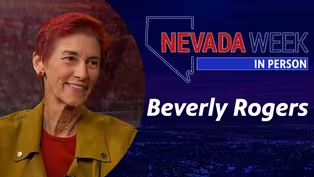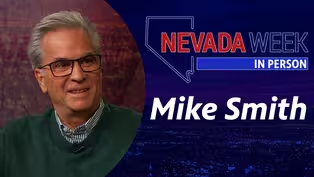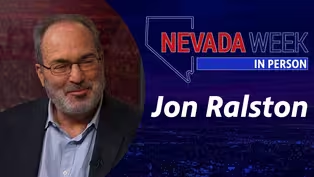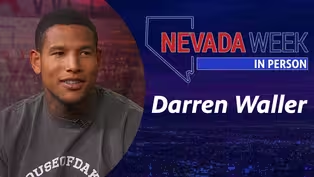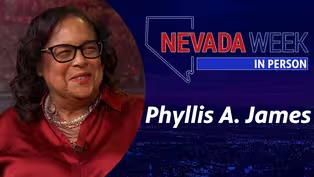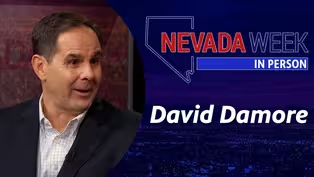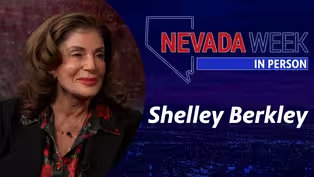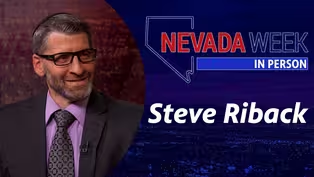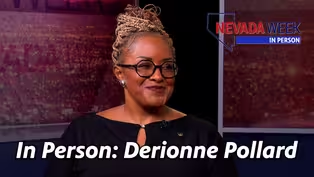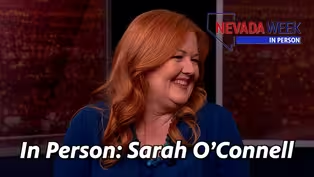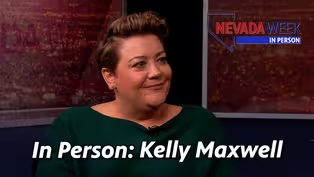
Nevada Week In Person | John Entsminger
Season 1 Episode 20 | 14mVideo has Closed Captions
One-on-one with SNWA General Manager John Entsminger.
A one-on-one interview with Southern Nevada Water Authority General Manager John Entsminger.
Problems playing video? | Closed Captioning Feedback
Problems playing video? | Closed Captioning Feedback
Nevada Week In Person is a local public television program presented by Vegas PBS

Nevada Week In Person | John Entsminger
Season 1 Episode 20 | 14mVideo has Closed Captions
A one-on-one interview with Southern Nevada Water Authority General Manager John Entsminger.
Problems playing video? | Closed Captioning Feedback
How to Watch Nevada Week In Person
Nevada Week In Person is available to stream on pbs.org and the free PBS App, available on iPhone, Apple TV, Android TV, Android smartphones, Amazon Fire TV, Amazon Fire Tablet, Roku, Samsung Smart TV, and Vizio.
Providing Support for PBS.org
Learn Moreabout PBS online sponsorshipMore from This Collection
Nevada Week In Person goes beyond the roundtable discussion of Nevada Week with guests for a more casual conversation about their personal passions, new projects and compelling stories that are overlooked in the flurry of the news cycle.
Nevada Week In Person | Beverly Rogers
Video has Closed Captions
One-on-one interview with Rogers Foundation chair Beverly Rogers. (14m)
Nevada Week In Person | Mike Smith
Video has Closed Captions
One-on-one interview with Las Vegas Sun political cartoonist Mike Smith. (14m)
Nevada Week In Person | Jon Ralston
Video has Closed Captions
One-on-one interview with The Nevada Independent CEO Jon Ralston. (14m)
Nevada Week In Person | Darren Waller
Video has Closed Captions
One-on-one interview with Las Vegas Raider tight end Darren Waller. (14m)
Nevada Week In Person | Phyllis A. James
Video has Closed Captions
One-on-one interview Phyllis A. James. (14m)
Nevada Week In Person | David Damore
Video has Closed Captions
One-on-one interview with Chair of the Department of Political Science at UNLV David Damor (14m)
Nevada Week In Person | Shelley Berkley
Video has Closed Captions
One-on-one interview Senior Vice President for Touro University Shelley Berkley. (14m)
Nevada Week In Person | Liz Ortenburger
Video has Closed Captions
One-on-one interview with SafeNest CEO Liz Ortenburger. (14m)
Nevada Week In Person | Steve Riback
Video has Closed Captions
One-on-one interview with Las Vegas Metro Police Lieutenant Steve Riback. (14m)
Nevada Week In Person | DeRionne Pollard
Video has Closed Captions
One-on-one interview Nevada State College President DeRionne Pollard. (14m)
Nevada Week In Person | Sarah O’Connell
Video has Closed Captions
One-on-one interview with Director of Eat More Art LLC Sarah O’Connell. (14m)
Nevada Week In Person | Kelly Maxwell
Video has Closed Captions
One-on-one interview with Baby’s Bounty Executive Director Kelly Maxwell. (14m)
Providing Support for PBS.org
Learn Moreabout PBS online sponsorshipWater is our most precious resource, and joining us this week on Nevada Week In Person is the man tasked with making sure it continues to flow in Southern Nevada, Southern Nevada Water Authority General Manager John Entsminger.
♪♪♪ Support for Nevada Week In Person is provided by Senator William H. Herndstadt and additional supporting sponsors.
(Amber Renee Dixon) The southwestern United States has been in a drought for more than two decades, which makes managing Southern Nevada's water supply one of the most important and difficult jobs in our state.
The person who has been doing that for almost a decade is John Entsminger, the general manager of the Southern Nevada Water Authority, or SNWA.
John, thank you for joining us.
-Thank you very much for having me.
-I made a joke prior to us starting that you moved to Las Vegas about 20 years ago, and that's when the drought started.
What's the connection?
-Well, I hope I'm not the root.
(laughter) Of course not, of course not.
You are from Colorado, correct?
-That's correct.
-So you grew up there, and when did your interest in water start?
(John Entsminger) Really I think it's kind of in my blood.
You know, growing up in Colorado, we did a lot of hunting, a lot of fishing, you know, it was kind of the headwaters of the Colorado River.
But I really got interested probably between college and law school.
I had read a couple of books about water law, and compared to torts and civil procedure and criminal law, it seemed very interesting.
-Who gave you those books about water law?
-Before the first year of law school, they gave us a list of books and they were on that list, so I read them.
-So prior to law school at the University of Colorado, you got a degree in history, I believe, with a minor in legal studies, and you intended to teach in high school, right?
-That was the original intent, and then I did some of my student teaching and actually got into a classroom and discovered that wasn't for me.
-What was it about the classroom setting that you thought, nope?
-The high school students.
(laughter) Okay, so you're not going to be contributing, helping out with our teacher shortage here anytime soon.
-Well, I certainly learned to admire the teaching profession and the men and women that devote their careers to that, because it's not as easy as it looks.
-So you go into law school, and you read those books about water.
What intrigued you about water law?
-Just how foundational it was to everything our society was trying to accomplish, particularly in the western U.S.
The whole West is a semi-arid environment, and that's before the onset of the last 20 years of drought.
So it intrigued me that, you know, you really got to work with the foundational elements of what made our country work.
-How did you come upon this job in Southern Nevada?
You started out with the Water Authority at a lower level.
What was that position and how did you get it?
-Yes.
So during my third year of law school, the Southern Nevada Water Authority actually did on-campus interviewing at the University of Colorado at Boulder, and I interviewed for the job, wound up getting a second interview and came to Las Vegas, met with everybody and wound up, you know, getting offered the job.
So I came into the organization through the office of general counsel and actually practiced water law and environmental compliance law from '99 to 2010 before they asked me to move on to the management team.
-What was that shock like, or was it a shock, moving from Colorado to the desert?
-It was a shock, but it was still the West, right?
I think there's a big difference between the western U.S. and the eastern U.S. so in some ways, you know, the spirit of the West was very similar from Colorado to Nevada.
-When you started in negotiations around water supply or water usage, who gets what, what was that like?
Did you find anything about negotiations that surprised you?
Did law school prepare you to negotiate?
-No, but fortunately I wasn't immediately on the front line, right?
So I learned from some amazing people that had worked in water law for decades and got to see how they handled it, but the most interesting thing was you have, you know, seven states, each with their own parochial best interests coming to the table, trying to represent back home but at the same time, everyone realizing that if we can't reach a common understanding about how to share this river, then ultimately that leads to litigation and other people making decisions for you.
-We're talking about the Colorado River, and that is what you are responsible for negotiating among those seven states that you mentioned, Nevada included, and that goes back to the Colorado River Compact, established in 1922, November 24.
This year will mark the 100-year anniversary.
What did that do, and how prevalent is it still today and impactful?
-So the 1922 Compact essentially divided the river in half.
The four upper division states, Colorado, Wyoming, Utah and New Mexico got 7.5 million acre feet, and then the lower division states, Arizona, Nevada and California, got 7.5 million acre feet.
So that's the cornerstone of the law of the river, but over the last 100 years, we've added new statutes.
We added a treaty with Mexico so, you know, incrementally the law has evolved.
But it all started with that Compact in 1922.
-It kind of sounds like the U.S. Constitution.
-It's very similar.
I've actually made that comparison before because you don't have-- you know, you don't have a murder charge embedded in the Constitution, you have to write statutes about that later on.
So a lot of the details of the law of the river actually aren't even in the Compact.
-But you still have to refer to it and interpret what the intention was at that time.
-Yes.
Well, it's basically a treaty between the states.
When you enter into an interstate compact, which is under the Compact Clause of the U.S. Constitution, all seven state legislatures had to approve it, both houses of Congress and the President.
So these are not easy things to change or amend.
That was the deal that was made by the states, you know, 100 years ago.
-And when that was made, the allocations of water, how much each state gets, Nevada sort of got the raw end of the deal, right?
-Well, we got the short end of the stick, there's no doubt about that.
But at the time, I believe in 1922 when the Compact was signed, the population of Clark County was 5- or 6,000 people.
So there wasn't, you know, any idea that Southern Nevada could grow to be what it is today.
But yes, if you add up all of the legal entitlements between seven states plus the country of Mexico, Nevada has a legal entitlement to 1.8% of the river.
-Yet our population has grown, in comparison, how much bigger?
-Well, we're at 2.3 million compared to 5,000.
If you want to measure over the last 20 years, since 2002, it's approximately 800,000 more residents.
But our water usage is down 26% in the same time period.
-All right.
That's a lot of numbers there.
(laughter) Okay.
So if we take into account the growth of Southern Nevada and Nevada in general, why can't our water allotment be changed, or can it be changed from what was established way back when?
-Well, I think you have two main factors.
You have the reality of the hydrology and climate change, and the Colorado is a shrinking river.
There's far less water in the river today than there was 100 years ago.
Plus politics.
I mentioned seven state legislatures, both houses of Congress and the President to change those allocations.
Your faith in our democratic institutions might be a little higher than mine, but I don't see a real probability of getting all those legislative bodies to agree to something like that.
-Well, you've been on the frontlines of it, and among your most proud accomplishments are the 2007 Colorado River Interim Guidelines.
What did that accomplish?
-It really got the seven states to agree A, what are the initial cuts in a shortage condition going to be, and it also set up the rules of the road for how Lake Mead and Lake Powell operate together, and then lastly, it established new rules for how people could bank unused water and then take that in future years.
So it injected a lot more certainty and a lot more flexibility into the law of the river than had previously existed.
-That is something we are subjected to right now, what you implemented in 2007, right?
-That's correct.
-How so?
-In 2021, the Secretary of the Interior declared the first-ever shortage condition in the Lower Colorado River, and that pre-agreed-upon lake level that triggered that shortage was one of the elements of those 2007 guidelines.
-Minute 319 in the 1944 U.S.-Mexico Water Treaty.
What does that mean?
And it's another one of your accomplishments that you're so proud of.
-Sure.
So a "minute" to a treaty is kind of like an addendum.
You're not taking the entire treaty back to the Senate for ratification, you're putting an addendum onto the treaty.
And what Minute 319 did was A, got Mexico to agree to take shortages at the exact same elevations that water users in the U.S. had agreed to, it allowed Mexico to use our infrastructure so if they had unused water under the treaty, they could bank it in Lake Mead because they don't have the topography in that part of the river to really be able to build that kind of infrastructure for themselves.
But it also did a pulse flow, an environmental flow that released Mexico's water from the lake, down to the delta and into the Gulf of California, which was the first time in 30 or 40 years the Colorado River actually reached the ocean.
-Wow.
That brings me to desalination and discussion about why can't the U.S. and Mexico be like Israel and Jordan?
And you're going to have to help me to explain how this would even work.
Would this work in getting us more water?
-So I think if I get out my crystal ball, I think there will be major new desalination facilities on the West Coast of North America, be that Mexico or California, in the next 30 or 40 years.
-And what is desalination?
-Desalination is the process of taking seawater, you know, pushing it through filters until it's potable and then serving it to the people.
-How exciting.
Did you say how much time you think until that actually happened?
-I think it's still decades out, but I think it's getting closer because of the situation with the drought.
But it's very expensive.
It takes an enormous amount of electricity to push water through those filters and you then have to dispose of the brine.
So it's not a panacea.
There's some real-world problems with implementing it, but given the shortage conditions on the river, I think those investments are going to start to make a lot more sense pretty soon.
-In your estimation, who would be paying for that?
Would that be the United States or Mexico or a combo?
-I think it will ultimately be a combination of the U.S. federal government and then big water utilities, so people like the Southern Nevada Water Authority, people like the Metropolitan Water District of Southern California.
I think that'll be a federal/state/local partnership to build those kinds of facilities.
-On a more personal note, does John Entsminger own a pool?
-I do.
It was at the house when I bought it.
So I would like to say I didn't take out the pre-existing pool.
-But are pools considered to be bad use of water if we're talking about conservation?
-I don't think a modest pool is a bad use of water.
I recognize we live in the Mojave Desert.
I think if you have a 600 square-foot pool in your backyard, that's not bad.
We have seen in some higher-end homes 3,000, 4,000, 5,000 square-foot water features that are just a ridiculous use of water in the Mojave Desert.
-Are you working on anything to put restrictions on that?
-We do have in our resource plan, which has to go to local agencies, we're proposing to limit new pool construction to 600 square feet.
-Do you own any grass?
-I have not a single blade of grass at my home.
-What are some of your biggest pet peeves concerning water use, personal water use?
-You know, it's the non-functional stuff.
I mean, the very small strips of grass at gas stations when you pull in, and water is shooting over on both sides and the sidewalk is literally black from 20 years of the sidewalk being watered instead of the grass.
Traffic circles where the poor lawnmower guy, I picture him at 4 a.m. trying to get the lawnmower out to the middle of a traffic circle and mow the lawn.
If your kids and grandkids can't play frisbee, I don't like that grass.
-I see we're getting your blood boiling.
John Entsminger, thank you so much for joining us on Nevada Week In Person.
John Entsminger also appeared on this week's Nevada Week, giving us his take on water and its role in economic development.
To see that episode, tune in on Sunday at 5:30 p.m. and Tuesday at 7:30 p.m. or anytime you wish at vegaspbs.org/nevadaweek.
Thanks for watching.

- News and Public Affairs

Top journalists deliver compelling original analysis of the hour's headlines.

- News and Public Affairs

FRONTLINE is investigative journalism that questions, explains and changes our world.












Support for PBS provided by:
Nevada Week In Person is a local public television program presented by Vegas PBS
